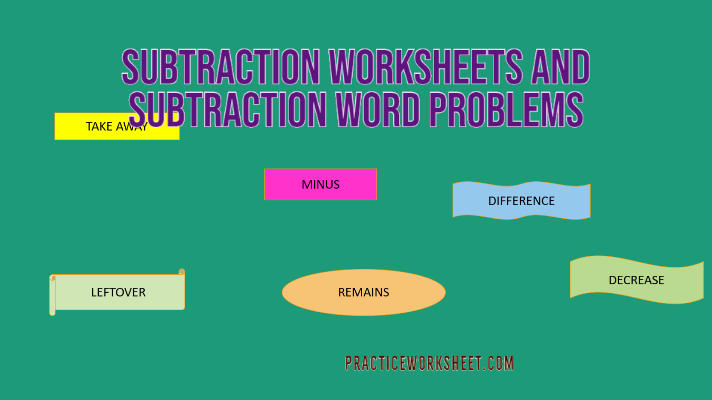This geometry worksheet will deal with Points, Lines, Rays, and Angles. Before diving into the geometry worksheet let’s recapitulate the terms that you already know.
What is a Point in geometry?
A point is a geometrical idea which is denoted by a dot. The point has a position but no magnitude. It is a basic unit of geometry that shows an exact location.
What is a Line in geometry?
A line can be defined as a collection of points that extends endlessly towards both directions. A line is generated arranging an infinite number of points side by side. A line has a length but no breadth. A line neither has a start point, nor an endpoint. A part of a line is called a line segment which has a start point and an endpoint. If A line segment starts at point A and ends at point B it can be denoted by point AB and the length of this line segment can be measured by a ruler or scale.
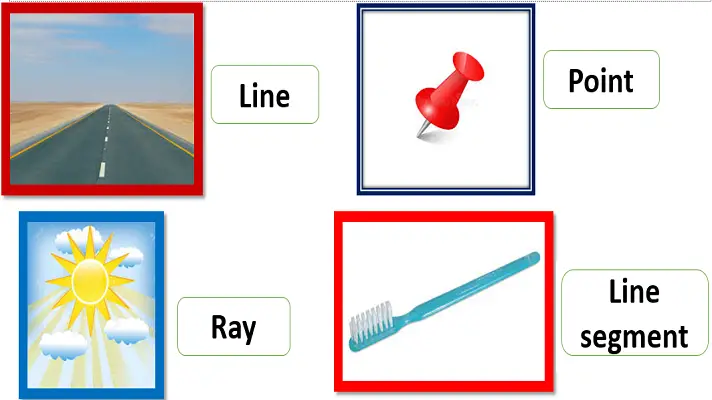
There are two types of lines
- Straight line and
- Curved line
When a point moves without changing direction it traces a straight line. On the other hand if the point changes direction it will trace a curved line. A straight line is named by two points whereas a curved line is named by a minimum of three points.
Remember that, Two-point P and Q can be joined by an infinite number of curved lines but there will be only one straight line joining them. The straight length will be the shortest distance between point P and Q.
When two straight lines do not intersect even after extending infinitely in both directions and remain equidistant, they are called parallel lines. However, if they meet or intersect they are called intersecting lines.
Note that two straight lines can meet at one point only.
What is a Ray in geometry?
In geometric concepts, A ray is a part of a line that starts at some point (or point of origin) and extends infinitely in one direction. So Ray has a start point but no endpoint. For example, A torchlight or one-way road can be considered as a Ray.
What is an angle in geometry?
When two straight lines meet at a point they form an angle. Angles are measured in degrees, using a protractor. Refer to Fig. 2 and Remember the following information about angles:
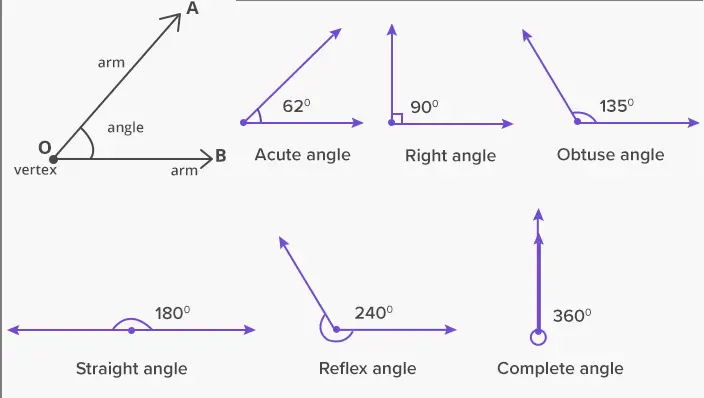
- The common point where the lines meet is called the vertex and lines are called arms of sides of the angle.
- An angle that measures 90 degrees is called a right angle.
- An angle that measures less than 90 degrees is called an acute angle.
- An angle that measures more than 90 degrees but less than 180 degrees is an obtuse angle.
- An angle with 180 degrees measure is a straight angle.
- An angle that measures more than 180 degrees but less than 360 degrees is called a reflex angle.
- An angle that measures 360 degrees is called a total angle.
Geometry Worksheet: Points, Lines, Rays and Angles
A. Which geometric term represents the following objects?
a. Tip of a Pen
b. Sides of a triangle.
c. Vertices of a cuboid.
d. Tip of an arrow
e. Edge of a rectangular table
f. Torch Light
g. One Way Road
B. Fill in the blanks with the correct answer
a. An octagon has _________________ number of more angles than a hexagon
b. A line constitutes of an _____________ number of points.
c. A line is made up of an _____________ number of line segments.
d. A ray has a starting point but no ending point. True or False? ________.
e. Protractor : Angle :: ______________ : Line Segment
f. I am made up of numerous points. I am not Straight. I am a __________ line.
g. Two fixed points can be joined by an infinite number of ___________ lines.
h. An angle has _________ arms and ________ vertex.
i. If two lines meet at a point they form an _____________.
j. The vertex of an angle is a ______________.
k. A _______________ is pictured by a dot.
l. When two straight lines never cross they are called ______________ lines.
m. Two straight lines can intersect at ___________ point only.
n. An Octagon has ____________ number of line segments.
C. Answer the following questions
a. Whats is the meaning of a line segment?
b. Which instrument do you use to measure the length of a line segment?
c. How many straight lines you can draw using two fixed points?
d. What is an Angle?
e. What is the meaning of the term Geometry?
f. Can you name four items in your school that contain right angles?
g. We can draw many straight lines to join two fixed points. True or False?
h. Explain the terms and give examples: Acute Angle, Obtuse Angle, and Right Angle
i. Two lines can be said as perpendicular to each other when they make a right angle. True or False?
j. Minimum How many sides are required to enclose a space?
k. What is the difference between a Line and a Ray?
l. How many endpoints does a Ray and Line Segment have?
m. How many angles does a heptagon have?
D. Refer to the below image and Answer the questions below
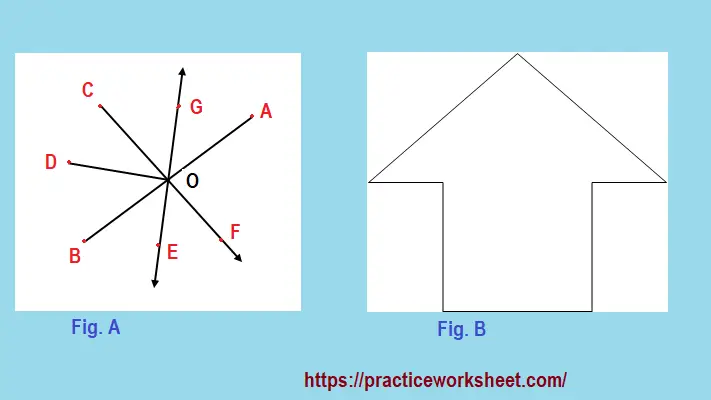
Refer to Fig. A and choose the correct answer for the following questions:
a. AB is a _______ (Line Segment/Ray/Line/Point/Angle).
b. OD is a ________ (Line Segment/Ray/Line/Point/Angle).
c. How many line segments passes through point O _____________. (3/4/5/6/7)
d. AOC is an ___ (Line Segment/Ray/Line/Point/Angle).
e. GE is a ____ (Line Segment/Ray/Line/Point).
f. CF is a _______ (Line Segment/Ray/Line/Point).
g. If angle AOC and angle BOC are equal, line segment AB and OC are ______ (Perpendicular/Parallel)
h. If angle AOC and angle BOC are equal, they are called ________________ angle (Right/Acute/Obtuse)
i. If CF is a ray then OF is ___________ (Line Segment/Ray/Line/Point/Angle)
j. If we join points E, B, D, C, and G it will create a _________ line (straight/curved)
Now refer to Fig. B and answer the following.
a. Number of line segments are _____.
b. Number of angles are ___________.
c. Number of vertices are _________.
E. How many types of angles do you know?
Few more useful worksheets for you:
Subtraction Worksheet
Addition Worksheet
Polygon and Circle Worksheet
Place value, Face value, Comparing Number Worksheet
Place Value Worksheet
Fraction Worksheet

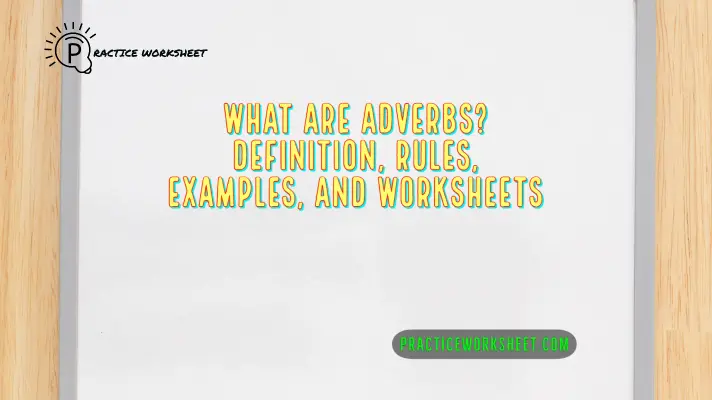
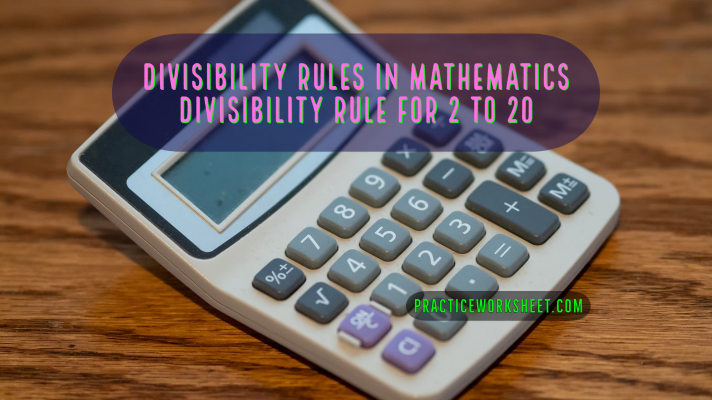
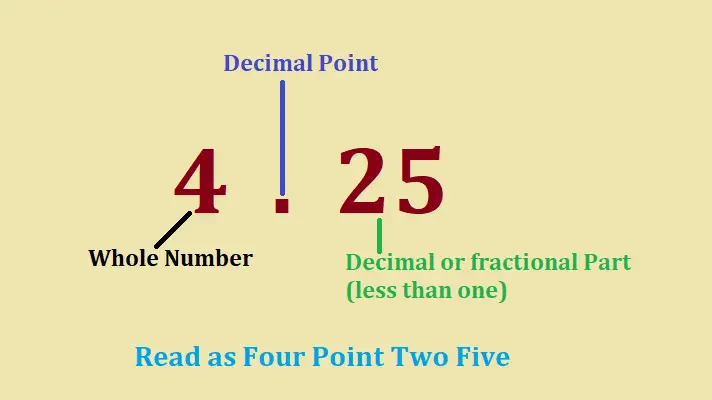
![Collective Nouns: Definition, Examples, and Worksheet [With PDF] Collective Nouns Worksheet](https://practiceworksheet.com/wp-content/uploads/2020/03/Collective-Nouns-Worksheet.png)
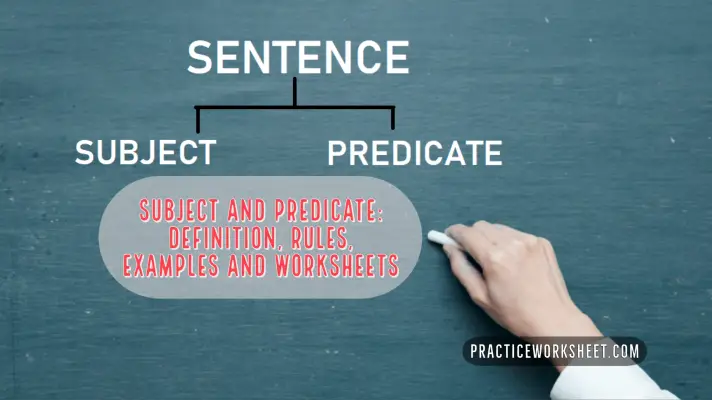
![Worksheet: Place Value, Face Value, Expanded Form and Comparing Numbers [With PDF] Place Value, Face Value, Expanded Form and Comparing Numbers](https://practiceworksheet.com/wp-content/uploads/2020/04/Place-Value-Face-Value-Expanded-Form-and-Comparing-Numbers.png)
